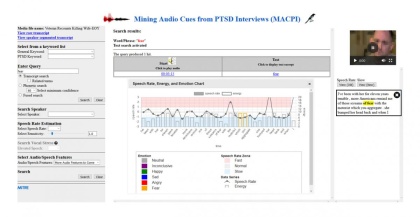Thousands of veterans suffer from Posttraumatic Stress Disorder, or PTSD. To improve diagnostic accuracy and identify PTSD sufferers quickly, MITRE researchers use natural language processing techniques to reveal signs hidden in the speech of veterans.

Exploring Speech Features to Assist PTSD Diagnosis
Posttraumatic Stress Disorder, or PTSD, is one of the most common psychiatric disorders affecting our nation’s veterans. You may know someone who came back from the wars in Iraq and Afghanistan with PTSD, but it’s not a new phenomenon. During the two World Wars, doctors often called it “shell shock.” PTSD symptoms include flashbacks, nightmares, avoidance of reminders of traumatic experiences, negative thoughts and moods, trouble concentrating, sleep difficulties, and irritability or anger.
Although reliable and valid diagnostic methods are available today, clinicians can make errors when attempting to identify who meets criteria for the disorder. This is because diagnosis relies exclusively on patient self-report--meaning that diagnostic accuracy is tied to how well patients can report on their symptoms. Intentional or unintentional response biases or misattributions can result in diagnostic errors.
Additionally, the gold standard for rendering a PTSD diagnosis is a structured diagnostic interview that requires administering clinicians to have appropriate training and expertise in PTSD and other mental disorders. These interviews can take anywhere from 40 to 60 minutes. Individuals with limited access to appropriately trained professionals or who may have difficulty fitting a one-hour mental health appointment into their hectic lives may go for some time before being identified as having PTSD. These impediments to proper and accurate diagnosis can lead to delays in receiving proper treatment and other services.
MITRE, in collaboration with Dr. Brian Marx and the Department of Veterans Affairs (VA) National Center for PTSD at VA Boston Healthcare System, is working to develop a new method of diagnosis that may circumvent existing obstacles to accurate and timely diagnosis of those with PTSD. Specifically, MITRE researchers have developed a research prototype system that systematically detects within an individual’s speech both lexical and vocal cues indicative of PTSD symptoms.
Giving Doctors Innovative Patient-Assessment Tools
Dr. Qian Hu, chief scientist for speech technology at MITRE, and her research team have developed a prototype called Mining Audio Cues from PTSD Interviews (MACPI) to help doctors systematically process and analyze PTSD interview recordings for PTSD diagnosis. Dr. Hu emphasizes that the tool does not replace doctors but gives them an objective assessment tool to aid their clinical analysis.
Hu and her team—consisting of researchers and engineers in multiple disciplines—tested and implemented her concept for the MACPI system within MITRE’s independent research and development program. The software-based process uses automatic speech-to-text transcription and algorithms for audio feature extraction to detect PTSD indicative speech features, which can predict the likelihood of PTSD. Dr. Hu’s team uses natural language processing and machine-learning algorithms to automatically detect words and phrases, speech patterns, and audio characteristics that help identify individuals with PTSD. These system-detected markers are then indexed by the software and listed with the timestamps on the recording. This process allows clinicians to analyze the conversation by reviewing the questions and answers while listening to those specific parts of the interview.
MITRE’s researchers collaborated with Dr. Marx and his team, which provided longitudinal data for the project. The data includes more than 1,300 psychiatric assessments with consenting veterans who were previously evaluated for PTSD, as well as interview recordings conducted three times during the study.
How the MACPI System Works

The team’s web-based prototype looks at speech patterns such as pause duration, stops, where they occur, and how long. A PTSD patient may feel anger, fear, guilt, hesitation,and insecurity and those emotions can affect speech rate, pitch, energy and tone.
For instance, PTSD patients might increase their speech rate and energy while describing a battle scene. Or they might not talk about it all or say, “can’t remember.” In response to certain questions, there may be increased silence, false starts, restarts, and self-corrections. In another example: When a soldier talks about his struggle with depression and PTSD, his speech rate slows when he mentions “guilt.”
Efficiency, Consistency, and Accuracy Count
Dr. Hu and her team delivered all components of the MITRE research software to VA Boston for further evaluation. To expand the research’s reach, Dr. Hu has also begun sharing the research findings with the broader medical community, including a presentation at the 2017 Stanford Medicine X Conference.
“Once a patient receives a diagnosis, the process can then assist clinicians to systematically monitor treatment progress,” Dr. Hu says. “That contributes to the long-term care and treatment of PTSD patients. And, with some adaptation, the software can also detect indicators of other mental disorders.
“This capability increases the efficiency, consistency, and accuracy of PTSD diagnosis with repeatable analysis and evidence. It assists clinicians to accurately diagnose PTSD and enable early treatment. Earlier treatment can reduce mental healthcare costs and—most important—save lives.”
Dr. Hu and her team are continuing their research to develop multiple predictive models and enable clinicians to select various types of risk factors with varying weights to provide diagnostic predictions. They are continuing the research collaboration with Dr. Marx and VA Boston to develop a prediction prototype that combines the efforts of humans and machines. MITRE is also interested in transferring this IP to others for the good of the nation and the world. If you are interested, please contact us. The stakes could hardly be higher.